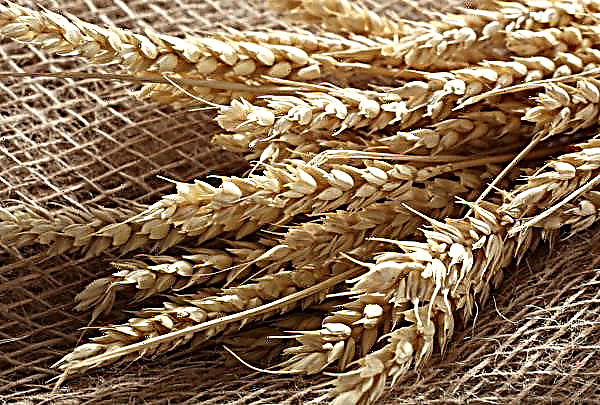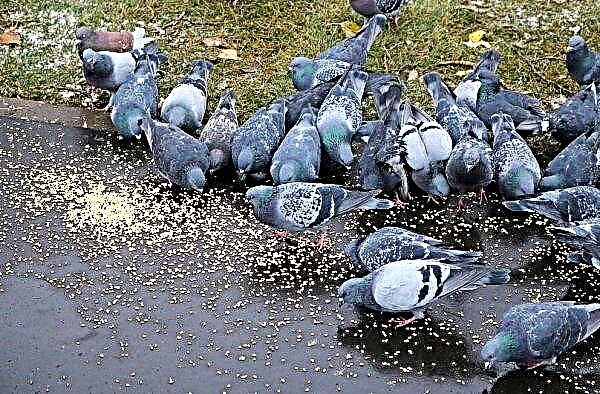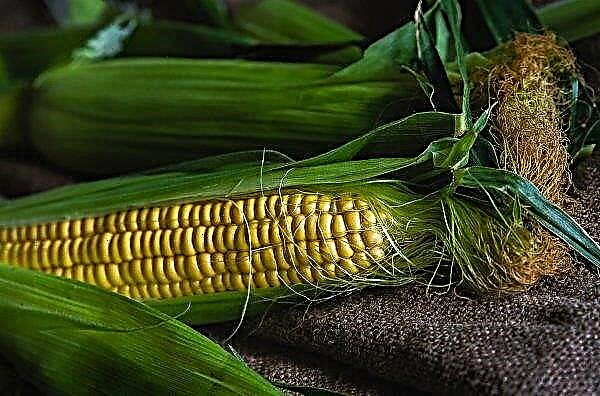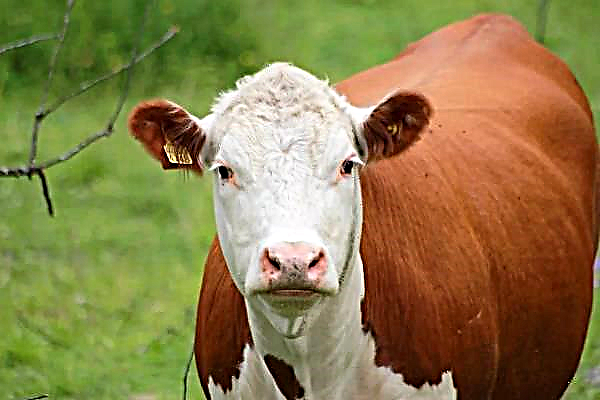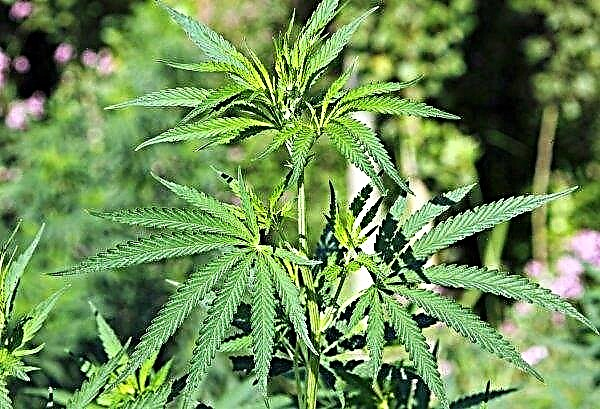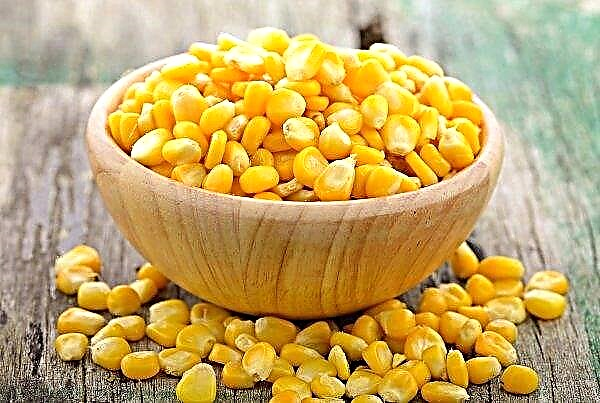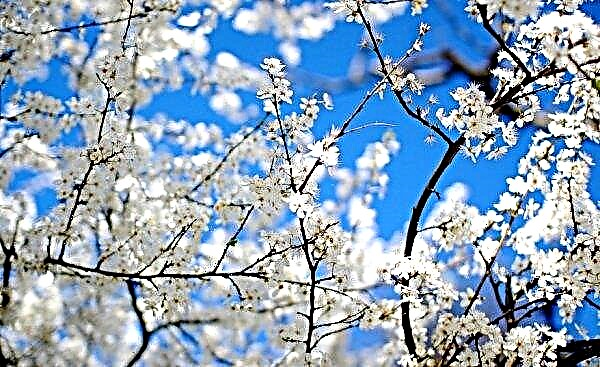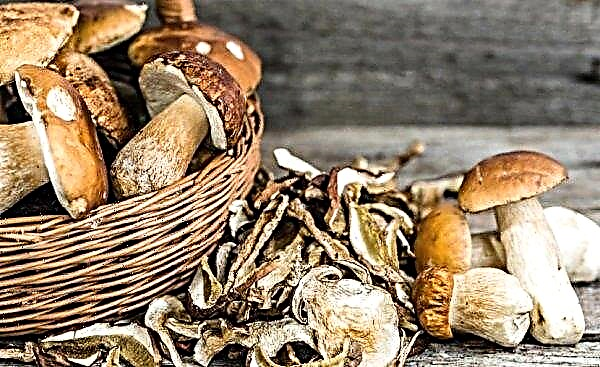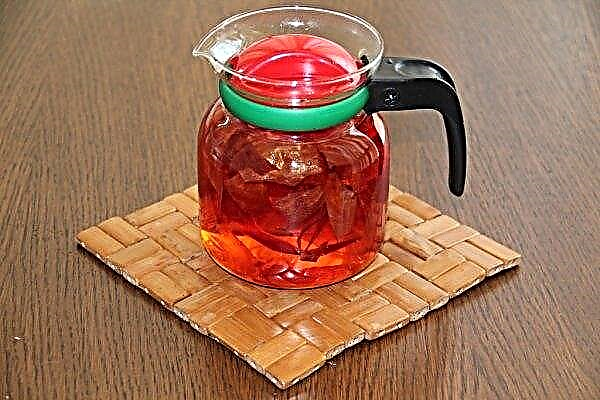The first crop of vegetables begins with a radish. It is grown very easily and grows very quickly. However, pests can attack even early plant species. Learn about the problems that radishes have and how to treat them - find out from this review.
Radish pests and control
Radish is a vegetable from the cabbage family. Its edible part is the root. After planting in the ground, the farmer may experience various problems.
Did you know? Presumably the first radish was cultivated in China 1000 years ago. He got to Europe only in the 1500s.
So, the appearance of pests and diseases is often preceded by non-compliance with growing conditions:
- Radish is a short daylight plant. If you plant it late (in June), when the day is gaining maximum length, then there is a flare (shooting) in which there are flowers, but the root crop does not form.
- Too nutritious soil with an overabundance of nitrogenous fertilizers will cause the vegetable to “go to the top”, forming a plentiful leaf part and small tubers.
- Lack of moisture and an abundance of weeds leads to the fact that the plant goes into the arrow, and the root crop becomes small and bitter. Overripening the crop will also be the reason why radish is bitter.
- With any deviation from the normal level of humidity (the soil should always be slightly moist) - the tubers do not set.
 Planting seeds in moist soil in April will ensure good plant development. A normally developing radish does not shoot and will not bloom until a root crop is formed. Excessive or insufficient humidity combined with air temperature will contribute to the spread of fungal infections. Among them: mosaic, rot, vascular bacteriosis, black leg.
Planting seeds in moist soil in April will ensure good plant development. A normally developing radish does not shoot and will not bloom until a root crop is formed. Excessive or insufficient humidity combined with air temperature will contribute to the spread of fungal infections. Among them: mosaic, rot, vascular bacteriosis, black leg.Other reasons why radishes do not grow are pests:
- sucking insects that feed on plant sap;
- various root eaters, due to which the radish is damaged, blackens inside and begins to rot.
Cruciferous flea
Cruciferous flea is a few species of beetles of the family Chrysomelidae. Most often, you can observe black bugs with a metallic tint that jump over the plant. But there are also other types of coloring: blue and brown fleas. The size of one insect is 2-3 mm. This is a type of sucking pests that bite through leaves and other parts of the radish, leaving small holes.
Signs of appearance:
- microholes on radish leaves;
- pitting surface of the sheet plate;
- the death of the epithelium along the edges of damaged areas.
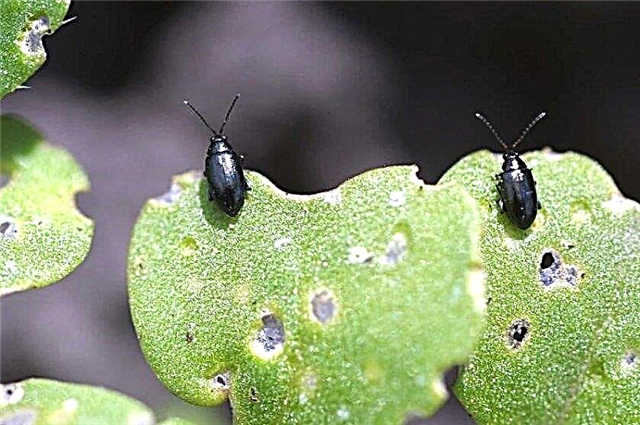 They do not damage root crops, but can be carriers of diseases that infect other plants. Fleas love warm, dry conditions and attack plants that lack water. Irrigation helps radishes grow as well as survive a flea attack.
They do not damage root crops, but can be carriers of diseases that infect other plants. Fleas love warm, dry conditions and attack plants that lack water. Irrigation helps radishes grow as well as survive a flea attack.The most effective control measures are traps. These are planks lubricated with an adhesive (glue, honey) and located between rows. Fleas move extremely often. Therefore, after some time, most of them will stick to the adhesive surface. Also, as a control measure, plants are pollinated with wood ash.
Important! Fleas prefer young leaves and young shoots. If no measures are taken in time, the young radish will die in 2–3 days.
Butterfly Caterpillars
Belyanki are beautiful butterflies with white, yellow or beige coloring of wings with small spots and stripes. The size of the insect is 4.5–6 cm. The leaves of plants feed on the caterpillars of the whitewash.
Signs of the presence of tracks:
- pitted edges of the sheet plate;
- damage to the stems.
 Caterpillars live on the bottom of the leaf. To find them - just turn the sheet. This allows you to collect the tracks manually, without resorting to the use of chemicals. It is not advisable to carry out treatment with bacterial preparations, since the ripening time of the radish is too short (20–25 days) so that the plants become safe to eat after treatment.
Caterpillars live on the bottom of the leaf. To find them - just turn the sheet. This allows you to collect the tracks manually, without resorting to the use of chemicals. It is not advisable to carry out treatment with bacterial preparations, since the ripening time of the radish is too short (20–25 days) so that the plants become safe to eat after treatment.Did you know? Belyanok scares off the smell of tomatoes. Therefore, they are recommended to be planted next to the radish.
Spring cabbage fly
Spring fly has a more elongated body than home. A distinctive feature is a black stripe on the abdomen. The body length is 6.5 mm. Fly larvae damage early spring plants.
Signs of pest:
- bluish shade of foliage;
- twisting and wilting of leaves;
- delayed plant development.

Methods of control and prevention:
- deep plowing of the site before planting;
- weed removal - as they attract flies;
- spraying with insecticides.
Crucifer bug
Cruciferous bug - an insect from the family of protectors. A characteristic feature of the pest is a dense chitinous shell. Each of the 30 species of bugs has its own color. Most of them are mottled, with a black pattern on the back. The length of the body is 10-12 mm. Damage is caused to both young and adult individuals. They bite through any parts of the plants.
Signs of a pest:
- corroded leaves;
- holes with a yellow rim around the holes;
- mucous traces due to mixing of plant juice with beetle enzymes;
- smelly smell.

Control measures:
- the bug does not attack the early varieties of radishes, so the earlier the sowing, the less likely the appearance of bugs;
- crop rotation compliance;
- electrical traps;
- a mulching layer that does not allow the bug to penetrate root crops.
Cabbage Moth
Cabbage moth is a rather small butterfly with a wingspan of up to 16 mm. Color - beige or yellowish. A sitting butterfly resembles a branch, so it is difficult to detect its presence. The danger of the pest is that the larvae of the cabbage moth consume leaves very intensively.
Signs of a pest:
- damaged leaves and tubers;
- growth retardation;
- signs of rot appear;
- there are drying leaves.
Did you know? In order to destroy the head of cabbage, only 2 larvae of the cabbage moth will be enough.
Cabbage fire
A butterfly in the shape of an equilateral triangle of brown-gray color with light spots on the leaves is a cabbage fire. The length of the butterfly is about 2 cm. Caterpillars of the firefly actively eat foliage for 14–35 days. Later, they go into the ground for further development, but this time is enough to cause damage to crops.
Signs of a firearm on the site:
- damage to the leaf root in the form of windows;
- large through holes on the sheet plate.

If you plant other cruciferous plants, the control measures will be as follows:
- deep loosening of soil in the fall;
- weed removal.
- Of the chemicals used "Ambush", "Anomertin" and others.
Did you know? The heaviest radish was grown in Japan in 2003. She was presented at the radish competition in Sakuradzhima. The root circle was 119 cm and weight 31.1 kg.
Rapeseed sawfly
A rapeseed sawfly is an orange-yellow hymenopteran insect. The length of the body is 7–8 mm. Wings are transparent, located along the body. The edges are framed by a black patterned border. It is a pest of all cruciferous. The sawfly nibbles the leaves. It lives there - on the underside of the sheet.
Therefore, you can notice its presence by:
- ulcerated edge of the leaf plate;
- the presence of sawfly larvae - these are caterpillars of a dark green color;
- damage to flowers and ovaries.

Pest control includes the following measures:
- treatment of crops with insecticides: Fastakom, Fufanon, Kinfosom;
- crop rotation should also be observed, crops should be protected from weeds, and the soil must be dug up to control wintering larvae.
Rapeseed Blossom
Rapeseed flower beetle is a small black beetle with a greenish tint. The shape of the insect is oval. Length - up to 2.7 mm. The beetle mainly feeds on pollen and damages the stamens and stigmas of flowers. Therefore, the radish, which leaves in color, is more attractive to the bee-eater than other plants.
Signs of a pest:
- withering flowers;
- shedding of pollen.
 Despite the fact that the beetle is dangerous to all cruciferous, you should not worry about radish crops when it bloomed. Flowering of a vegetable ends even before the appearance of a rapeseed beetle. But all the other cruciferous plants that go in color should be protected. Agrotechnical methods of pest control remain basic: weeding weeds, deep loosening of the soil.
Despite the fact that the beetle is dangerous to all cruciferous, you should not worry about radish crops when it bloomed. Flowering of a vegetable ends even before the appearance of a rapeseed beetle. But all the other cruciferous plants that go in color should be protected. Agrotechnical methods of pest control remain basic: weeding weeds, deep loosening of the soil.Did you know? Depending on the variety, the radish root crop can take various forms: from spherical to cylindrical or conical. The outer layer of the peel can be white, yellow, pink, red, purple or black.
Slug
Slugs are called all gastropod mollusks that do not have a shell. Garden slugs live in humid areas and can cause serious damage to crops. The size of the slugs can be any, including very large (about 10 cm). The body is wide, soft shades.
Signs of a pest:
- the presence of shiny mucous traces on the surfaces is the main sign of the presence of gastropod mollusks;
- ulcerated leaf surfaces.
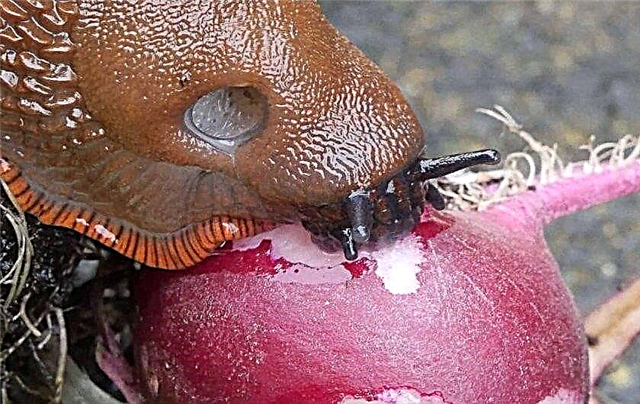
Control measures:
- row-spacing cultivation;
- weed control;
- decrease in site humidity;
- planting garlic, mustard, parsley or other plants that repel slugs;
- construction of barriers made of gravel, needles, lime to repel the pest.
Did you know? Ancient Asians used radish seed oil even before the ancient Egyptians started using olive oil.
Aphid
Cabbage aphids are insects about 2 mm long in greenish color. The wings in the expanded form exceed the size of the body by 2 times. The insect harms not only by drinking plant juice, but also by the fact that phytopathogens settle on damaged plant tissues.
Signs of a pest:
- colonies of small green insects on trunks and leaves;
- sticky coating on the leaves;
- deformed leaves in places of mass accumulation of aphids;
- the leaves turn yellow and discolor.

Pest control methods:
- treatment of crops with soapy water (300 g per bucket of water);
- it is possible to spray with preparations "Borey SK", "Decis KE" and others.
Babanuha
Babanukha is a small black beetle that affects cruciferous. Color - green, cast with bottle glass. The length of the convex body is 3-4 mm.
Babanukha is a leaf beetle, so the signs of his appearance are:
- gnawed leaves;
- in places of bites, the surface darkens, then begins to fade;
- leaf deformation.

Among the methods of combating beetle:
- weed removal;
- deep loosening of soil in the fall;
- early planting radish;
- crop rotation compliance;
- Crops are sprayed with dry ash.
Did you know? The first herbicides to remove weeds began to be used in ancient Rome. Then it was salt, ash and slag.
Common radish diseases and their treatment
Viral diseases are the result of the work of intracellular parasites - viruses. They are transmitted along with pests that feed on plant sap, and also winter on seed material.
Belle of cabbage crops (white rust)
Belle of cabbage crops results from the activity of the fungus Albugo candida. The disease is characterized by the appearance of white and yellow oily spots on the leaves, and fungal tissue (white, originally covered by the epidermis) forms on the lower part of the leaf. Heavily affected leaves dry and fall off. The stems are deformed and slow down their growth.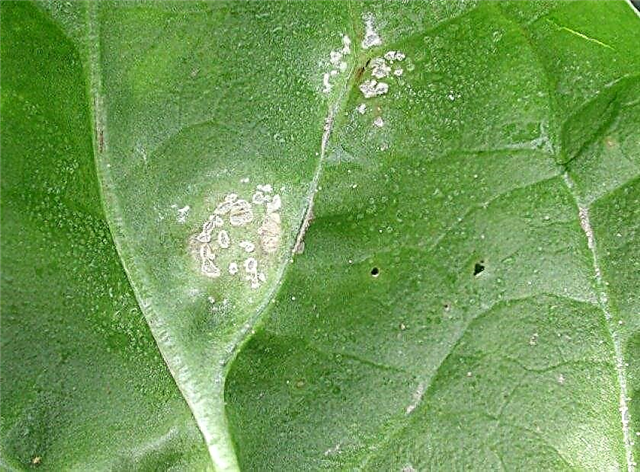
Control measures:
- collection and destruction of crop residues after harvesting;
- the use of healthy seeds;
- recommended spraying with preparations containing copper, including copper sulphate.
Kila
Kila is a disease that affects the root crop. Contamination of the soil and moisture contribute to the disease. Symptoms of the disease: the appearance of growths on the tuber. The growths acquire a dark shade and begin to rot.
Methods of struggle:
- the soil is disinfected with dry powder of bleach; make it at the rate of 200 g per 1 m² of soil;
- water the plot with a solution of colloidal sulfur (5%) before planting;
- mandatory crop rotation.
Important! The virus that causes Kiel remains in the ground for 5 years.
Radish Mosaic
Mosaic virus (CaMV) manifests itself in discoloration of the veins, after which the leaves turn yellow and their edges curl. The affected seedling suspends development and remains shallow. The virus is transmitted annually along with the seeds to the next crop.
Control measures:
- planting healthy, certified seeds;
- removal of plants that have mosaic signs;
- the use of insecticides to control insects.
Did you know? Radishes have their own holiday — this is Radish Night on December 23rd in Oaxaca, Mexico. The festival presents many Christmas scenes cut from radishes!
Powdery mildew
Powdery mildew occurs as a result of infection with the Peronospora virus. The disease manifests itself through the appearance on the leaves of individual yellow spots, which later turn brown. On the underside of the leaves there is a grayish “fluff”. In the growing season, mold spreads by air along with the wind, and high humidity promotes spread. Large, black, round spots appear on the root crop that destroy it.
Prevention measures:
- the use of powdery mildew resistant varieties;
- removal of infected plants;
- treatment with fungicides during the growing season;
- removal of vegetation residues from the site after harvesting.
Peronosporosis (downy mildew)
Peronosporosis (downy mildew) is caused by fungi of the Peronospora family. It appears in the form of small yellow spots, which later begin to grow. Affected leaves curl, dry and fall. The disease occurs with strong changes in day and night temperatures in the fall or spring.
Prevention measures:
- removal of fallen leaves and plant leaves, as the fungus hibernates in them;
- disinfection of seeds in a solution of potassium permanganate before planting;
- creation of conditions for plants with minimal temperature differences;
- the treatment consists in spraying with Fitosporin-M every 2 weeks.
Gray rot
Gray rot is caused by the fungus Botrytis cinerea. Symptoms of the disease: gray or brown small spots and thin lines between them on the leaves of the radish. The fungus can be on the leaves, but not manifest itself until the conditions for its development arise: low temperature and high humidity. Botrytis enters the plant tissue through damage. The disease can affect most garden plants. Therefore, appearing on some plants, it will certainly be on others.
Prevention measures:
- treat seeds before sowing with sulfur-based preparations;
- destruction of affected parts of plants;
- treatment of crops with a solution of Bordeaux fluid;
- make fertilizing with potash fertilizers.
Did you know? Botrytis is called the “warm corpse” parasite because it needs a patch of dead tissue to infect.
Vascular bacteriosis
Vascular bacteriosis appears on both sides of the leaves in the form of small, dark and moist spots. These spots are small, but they can develop in favorable weather. A purple border appears on old leaves. As a result of the development of the phytopathogen, they begin to fall.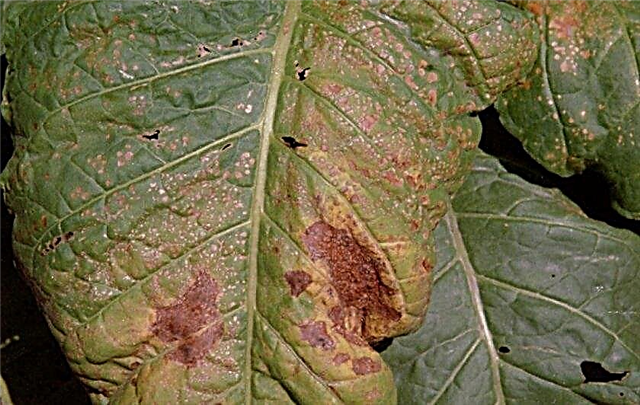
Control and prevention measures:
- avoid waterlogging of the soil;
- observe crop rotation;
- use only healthy seeds;
- treat the seeds before planting with hot water (+ 50 ° C) for 30 minutes;
- spray fungicides.
Blackleg
The black leg is a fungal disease that belongs to 2 different groups of phytopathogens. The first are molds that are in the soil. They affect all organics encountered: the root neck of the plant, roots, fallen leaves, etc. This type of black leg affects the stem, leading to its blackening and drying out.
Fusarium is a more aggressive type of pathogen that infects leaves and stems. Symptoms of lesion: blackened spots on the leaves. This type of black leg in a few hours completely affects the plant.
Control measures:
- seed treatment before planting by heating at + 50 ° C for half an hour and treatment with fungicides;
- destruction of all affected plants;
- soil cultivation in the affected area with a solution of potassium permanganate (0.2 g / l).
Did you know? Radishes can be divided into two groups based on planting time. In spring, summer species land. They have a round shape and pink color. Winter species are sown in late summer. This is an elongated white radish. It has a stronger (spicy) taste than summer varieties.
Scab
Radish scab can be no less unpleasant. The disease manifests itself in the form of black holes with an uneven edge in root crops. For prevention, weed removal and crop rotation are used, and the soil is acidified with fertilizers.
How to treat radishes from diseases and pests
Surgical treatment can be carried out by several methods. Each farmer chooses one or another approach.
Organic farming technologies offer natural ways to control pests:
- compliance with crop rotation, taking into account the length of the development cycle of the main pests;
- sowing in the aisles of plants that repel pests;
- the use of mulching materials, traps, protective cordons.
Providing the right conditions for growth also reduces the likelihood of infection. Be sure to provide the plants with enough space for free air circulation and remove weeds around the crops to prevent the plants from being densely populated and areas with high humidity that the pests need to grow.
Fighting folk methods include:
- processing of crops with wood ash;
- introduction of dolomite flour, sand into the soil to reduce soil density or normalize the level of acidity;
- spraying crops with a solution of soap, vinegar or other substances.
Alternative methods can be quite effective, but remember that with an abundance of pests, it will be better to use insecticides and other chemicals. When choosing how to water radishes from worms, aphids or other insects, focus on drugs with a wide spectrum of action. They work against several species of insects. In this case, you can not be afraid that you have incorrectly determined the type of pest. Modern industrial preparations are the thorough work of the research departments of leading agricultural companies and plant growing institutes in different countries. Their effects and side effects are carefully verified. Therefore, you will always be sure of the effectiveness of such funds.
Modern industrial preparations are the thorough work of the research departments of leading agricultural companies and plant growing institutes in different countries. Their effects and side effects are carefully verified. Therefore, you will always be sure of the effectiveness of such funds.
Start pest control with preventative measures. This reduces the risk of crop infection. Also keep in mind that radish is one of the earliest types of vegetables. Therefore, some pests are not dangerous to him. Create optimal conditions for plants to grow, destroy pests in time, and you will definitely get an excellent harvest.

